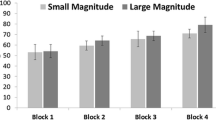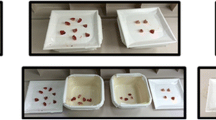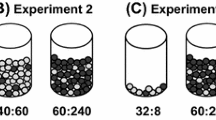Abstract
Recent assessments have shown that capuchin monkeys, like chimpanzees and other Old World primate species, are sensitive to quantitative differences between sets of visible stimuli. In the present study, we examined capuchins’ performance in a more sophisticated quantity judgment task that required the ability to form representations of food quantities while viewing the quantities only one piece at a time. In three experiments, we presented monkeys with the choice between two sets of discrete homogeneous food items and allowed the monkeys to consume the set of their choice. In Experiments 1 and 2, monkeys compared an entirely visible food set to a second set, presented item-by-item into an opaque container. All monkeys exhibited high accuracy in choosing the larger set, even when the entirely visible set was presented last, preventing the use of one-to-one item correspondence to compare quantities. In Experiment 3, monkeys compared two sets that were each presented item-by-item into opaque containers, but at different rates to control for temporal cues. Some monkeys performed well in this experiment, though others exhibited near-chance performance, suggesting that this species’ ability to form representations of food quantities may be limited compared to previously tested species such as chimpanzees. Overall, these findings support the analog magnitude model of quantity representation as an explanation for capuchin monkeys’ quantification of sequentially presented food items.


Similar content being viewed by others
Notes
This alternative explanation was offered by a referee during the review process, and we are grateful to him or her for the suggestion.
References
Addessi E, Crescimbene L, Visalberghi E (2007) Do capuchin monkeys (Cebus apella) use tokens as symbols? Proc R Soc Lond B 274:2579–2585
Addessi E, Crescimbene L, Visalberghi E (2008) Food and token quantity discrimination in capuchin monkeys (Cebus apella). Anim Cogn 11:275–282
Beran MJ (2001) Summation and numerousness judgments of sequentially presented sets of items by chimpanzees (Pan troglodytes). J Comp Psychol 115:181–191
Beran MJ (2004) Chimpanzees (Pan troglodytes) respond to nonvisible sets after one-by-one addition and removal of food items. J Comp Psychol 118:25–36
Beran MJ (2007a) Rhesus monkeys (Macaca mulatta) succeed on a computerized test designed to assess conservation of discrete quantity. Anim Cogn 10:37–45
Beran MJ (2007b) Rhesus monkeys (Macaca mulatta) enumerate large and small sequentially presented sets of items using analog numerical representations. J Exp Psychol Anim Behav Process 33:42–54
Beran MJ (2008) Capuchin monkeys (Cebus apella) succeed in a test of quantity conservation. Anim Cogn 11:109–116
Beran MJ, Beran MM (2004) Chimpanzees remember the results of one-by-one addition of food items to sets. Psychol Sci 15:94–99
Beran MJ, Harris EH, Evans TA, Klein ED, Chan B, Flemming TM, Washburn DA (2008a) Ordinal judgments of symbolic stimuli by capuchin monkeys (Cebus apella) and rhesus monkeys (Macaca mulatta): the effects of differential and nondifferential reward. J Comp Psychol 122:52–61
Beran MJ, Evans TA, Leighty KA, Harris EH, Rice D (2008b) Summation and quantity judgments of sequentially presented sets by capuchin monkeys (Cebus apella). Am J Primatol 70:191–194
Beran MJ, Evans TA, Harris EH (2008c) Perception of food amounts by chimpanzees based on the number, size, contour length and visibility of items. Anim Behav 75:1793–1802
Boysen ST, Bernston GG, Shreyer TA, Hannan MB (1995) Indicating acts during couting by a chimpanzee (Pan troglodytes). J Comp Psychol 109:47–51
Brannon EM, Roitman JD (2003) Nonverbal representations of time and number in animals and human infants. In: Neck WH (ed) Functional and neural mechanisms of interval timing. CRC Press, Boca Raton, pp 143–182
Brannon EM, Terrace HS (2000) Representation of the numerosities 1–9 by rhesus macaques (Macaca mulatta). J Exp Psychol Anim Behav Process 26:31–49
Cantlon JF, Brannon EM (2007) How much does number matter to a monkey (Macaca mulatta)? J Exp Psychol Anim Behav Process 33:32–41
Davis H, Memmott J (1982) Counting behavior in animals: a critical evaluation. Psychol Bull 92:547–571
Flombaum JI, Junge JA, Hauser MD (2005) Rhesus monkeys (Macaca mulatta) spontaneously compute addition operations over larger numbers. Cognition 97:315–325
Gallistel CR, Gelman R (2000) Nonverbal numerical cognition: from reals to integers. Trends Cogn Sci 4:59–65
Hanus D, Call J (2007) Discrete quantity judgments in the great apes (Pan paniscus, Pan troglodytes, Gorilla gorilla, Pongo pygmaeus): the effect of presenting whole sets versus item-by-item. J Exp Psychol Anim Behav Process 121:241–249
Hauser MD, Carey S, Hauser LB (2000) Spontaneous number representation in semi-free-ranging rhesus monkeys. Proc R Soc Lond B 267:829–833
Judge PG, Evans TA, Vyas DK (2005) Ordinal representation of numeric quantities by brown capuchin monkeys (Cebus apella). J Exp Psychol Anim Behav Process 31:79–94
Muncer SJ (1983) “Conservations” with a chimpanzee. Dev Psychol 16:1–11
Suda C, Call J (2005) Piagetian conservation of discrete quantities in bonobos (Pan paniscus), chimpanzees (Pan troglodytes), and orangutans (Pongo pygmaeus). Anim Cogn 8:220–235
Tomonaga M, Matsuzawa T (2000) Sequential responding to Arabic numerals with wild cards by the chimpanzee (Pan troglodytes). Anim Cogn 3:1–11
van Marle K, Aw J, McCrink K, Santos LR (2006) How capuchin monkeys (Cebus apella) quantify objects and substances. J Comp Psychol 120:416–426
Washburn DA, Rumbaugh DM (1991) Ordinal judgments of numerical symbols by macaques (Macaca mulatta). Psychol Sci 2:190–193
Acknowledgments
This research was supported by National Institutes of Health Grant HD-38051 to the Language Research Center of Georgia State University. We thank John Kelley, Sarah Hunsberger and Betty Chan for assistance with animal care and management. These experiments complied with the current laws of the United States of America.
Author information
Authors and Affiliations
Corresponding author
Rights and permissions
About this article
Cite this article
Evans, T.A., Beran, M.J., Harris, E.H. et al. Quantity judgments of sequentially presented food items by capuchin monkeys (Cebus apella). Anim Cogn 12, 97–105 (2009). https://doi.org/10.1007/s10071-008-0174-z
Received:
Revised:
Accepted:
Published:
Issue Date:
DOI: https://doi.org/10.1007/s10071-008-0174-z




